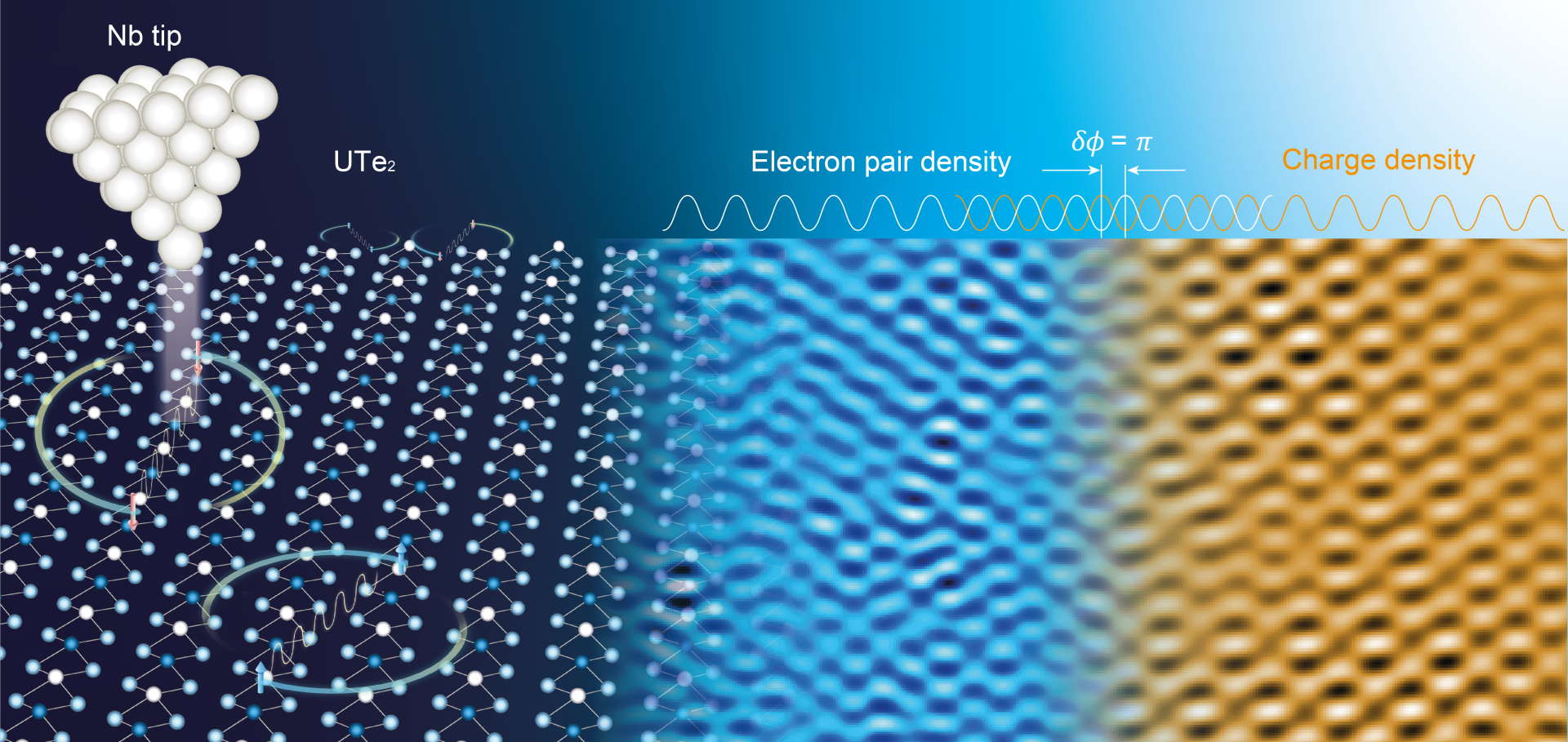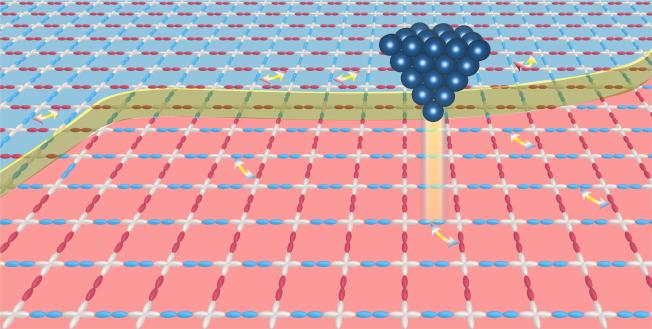Planar NbnOm Clusters on the Au(111) Surface
A class of planar niobium oxide atomic clusters ranging from Nb4O8 to Nb15O27 are synthesized through Nb evaporation in an ultra-high vacuum environment onto Au(111) substrates with subsequent annealing in oxygen. The clusters exhibit four-, five-, and six-fold rotational symmetry as determined through scanning tunnelling microscopy imaging. Their atomic structure and stoichiometry are determined via modelling using density functional theory.
Epitaxially Constrained Grain Boundary Structures in an Oxide Honeycomb Monolayer
Grain boundaries (GBs) are ubiquitous in solids. Their description is critical for understanding polycrystalline materials and explaining their mechanical and electrical properties. A GB in a 2D material can be described as a line defect and its atomic structures have been intensively studied in materials such as graphene. These GBs accommodate the relative rotation of two neighboring grains by incorporating periodic units consisting of nonhexagonal rings along the boundary. Zero-degree GBs, called domain boundaries (DBs), where there is only a lattice offset between two grains without any rotation, are rare in 2D van-der-Waals (vdW) bonded materials where the grains can easily move. However, this movement is not possible in 2D materials that have a strong epitaxial relationship with their substrate such as the M2O3 (2 × 2) honeycomb monolayers on noble metal (111) supports. Involving experimental and theoretical investigations, four main DBs are observed here in a monolayer of Ti2O3 supported on Au(111) and their atomic structures are solved. The DB formation energies explain why some DBs are more frequently observed than others. The strong epitaxial constraint from the Au(111) substrate stabilizes some unique Ti2O3 monolayer DB structures that are not observed in vdW-bonded 2D materials.
Rotational defects in a honeycomb lattice
Two-dimensional materials with a honeycomb lattice, such as graphene and hexagonal boron nitride, often contain local defects in which the hexagonal elements are replaced by four-, five-, seven-, and eight-membered rings. An example is the Stone–Wales (S–W) defect, where a bond rotation causes four hexagons to be transformed into a cluster of two pentagons and two heptagons. A further series of similar defects incorporating divacancies results in larger structures of non-hexagonal elements. In this paper, we use scanning tunneling microscopy (STM) and density functional theory (DFT) modeling to investigate the structure and energetics of S–W and divacancy defects in a honeycomb (2 × 2) Ti2O3 monolayer grown on an Au(111) substrate. The epitaxial rumpled Ti2O3 monolayer is pseudomorphic and in a state of elastic compression. As a consequence, divacancy defects, which induce tension in freestanding films, relieve the compression in the epitaxial Ti2O3 monolayer and therefore have significantly lower energies when compared with their freestanding counterparts. We find that at the divacancy defect sites there is a local reduction of the charge transfer between the film and the substrate, the rumpling is reduced, and the film has an increased separation from the substrate. Our results demonstrate the capacity of the substrate to significantly influence the energetics, and hence favor vacancy-type defects, in compressively strained 2D materials. This approach could be applied more broadly, for example to tensile monolayers, where vacancy-type defects would be rare and interstitial-type defects might be favored.
Atomic and electronic structure of an epitaxial Nb2O3 honeycomb monolayer on Au(111)
The experimental discovery and theoretical analysis of an epitaxial (2 × 2) honeycomb Nb2O3 monolayer on a Au(111) surface is reported. The oxide monolayer is grown by Nb deposition and subsequent annealing in an oxidizing atmosphere. Scanning tunneling microscopy (STM) images show that the films form a well-ordered honeycomb lattice, and low energy electron diffraction patterns confirm that the films adopt a (2 × 2) periodicity with respect to the Au(111) substrate. Density functional theory (DFT) modeling shows that the Nb atoms are located in Au(111) threefold hollow sites and the O atoms are located in on-top positions. DFT also demonstrates the existence of a strong interfacial interaction characterized by a large electron transfer towards the Au substrate, an increase of the Nb oxidation state, and substantial film rumpling. High-resolution STM images, supported by simulations, are able to discriminate between Nb atoms adsorbed in fcc or hcp hollow sites on the Au(111) substrate.
Maximising the resolving power of the scanning tunneling microscope
The usual way to present images from a scanning tunneling microscope (STM) is to take multiple images of the same area, to then manually select the one that appears to be of the highest quality, and then to discard the other almost identical images. This is in contrast to most other disciplines where the signal to noise ratio (SNR) of a data set is improved by taking repeated measurements and averaging them. Data averaging can be routinely performed for 1D spectra, where their alignment is straightforward. However, for serial-acquired 2D STM images the nature and variety of image distortions can severely complicate accurate registration. Here, we demonstrate how a significant improvement in the resolving power of the STM can be achieved through automated distortion correction and multi-frame averaging (MFA) and we demonstrate the broad utility of this approach with three examples. First, we show a sixfold enhancement of the SNR of the Si(111)-(7 × 7) reconstruction. Next, we demonstrate that images with sub-picometre height precision can be routinely obtained and show this for a monolayer of Ti2O3 on Au(111). Last, we demonstrate the automated classification of the two chiral variants of the surface unit cells of the (4 × 4) reconstructed SrTiO3(111) surface. Our new approach to STM imaging will allow a wealth of structural and electronic information from surfaces to be extracted that was previously buried in noise.
Single-layer TiOx reconstructions on SrTiO3 (111): (√7 × √7)R19.1°, (√13 × √13)R13.9°, and related structures
The atomic structures of two reconstructions, (√7 × √7)R19.1° and (√13 × √13)R13.9°, on the SrTiO3 (111) surface were determined using a combination of density functional theory and scanning tunneling microscopy data and APW + lo density functional theory minimizations and simulations. These reconstructions belong to the same structural family made up of an interconnected, single layer of edge-sharing TiO6 and TiO5[] octahedra. This family of reconstructions between 0.5 and 1.5 excess TiO2, representing the lowest-reported TiO2 coverages for reconstructions on this surface. This family is found to include the previously-solved (2 × 2)a reconstruction. They all follow a simple rule for surface composition, which serves as a tool for better understanding and predicting the structure of other reconstructions of arbitrary surface unit cell size on SrTiO3 (111). This reconstruction family and the calculations of surface energies for different hypothesis structures also shed light on the structure of Schottky defects observed on these reconstructed SrTO3 (111) surfaces.



